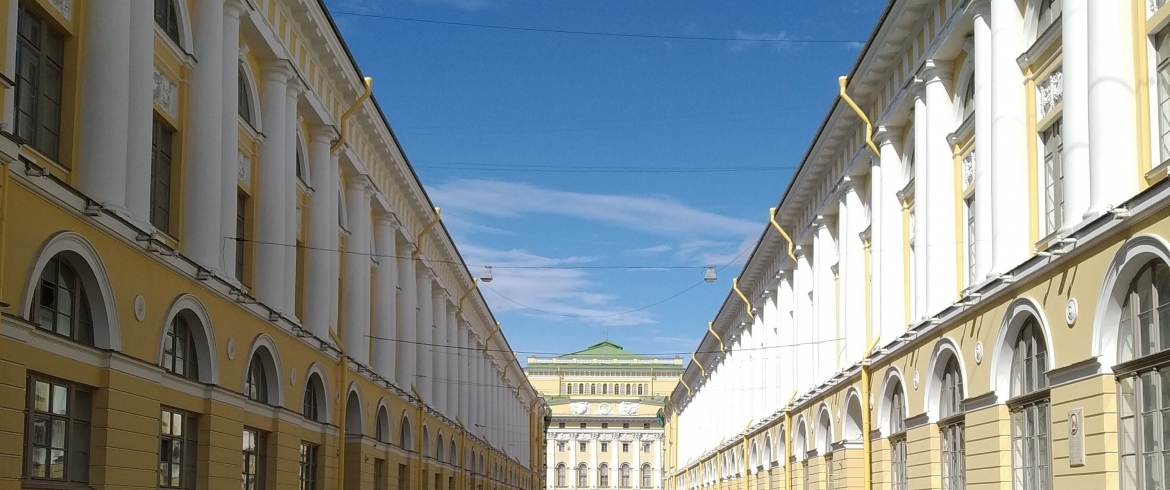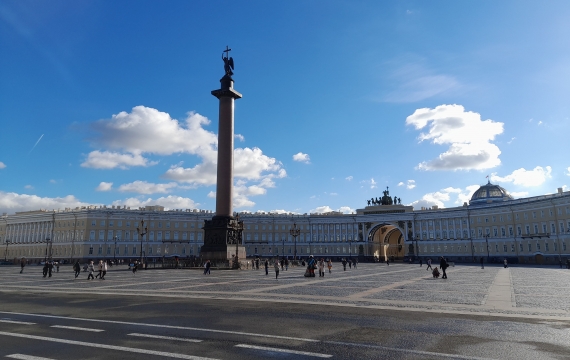City of the Architect Rossi

Start
Senat Sq.
Travel time
around 1 hr (calm step, excluding visits to museums)
Length
around 5 km
Finish
Lomonosov sq.
theme routes
What is this route?
Karl Ivanovich Rossi (1775-1849) is one of the most famous architects who created the unique look of St. Petersburg.
Carlo di Giovanni Rossi was born on December 18, 1775 in Naples, in 1787 he moved with his family to St. Petersburg. In his youth he studied with the architect Vincenzo Brenna, whom he helped with the construction of the Mikhailovsky Castle in 1796-1801.
Rossi's early independent works in St. Petersburg and its environs also include the pavilions and the library of the Pavlovsk Palace and the Elagin Palace with a greenhouse and pavilions. But the architect's main field of activity was the creation of ceremonial architectural ensembles of the Northern capital, which you will get to know on this route.
The architect died on April 6, 1849 in St. Petersburg, and was buried at the Volkov Lutheran cemetery. Reburied in 1940 at the Lazarevskoye cemetery of the Alexander Nevsky Lavra.
What can you expect?
The route starts at Senate Square, near the buildings of the Senate and Synod. The arch between them, according to the architect's plan, was intended to symbolize the unity of the state and the church. Now the Senate building is occupied by the Constitutional Court, and the Synod building is occupied by the Yeltsin Presidential Library.
Your path lies along the Admiralty Embankment, the front pier with lions - the creation of Karl Rossi. Interestingly, historically, the pier was located slightly upstream - where today the Palace Bridge is.
The ensemble of Palace Square - the main ceremonial square of St. Petersburg - was formed in the 1820s, when the General Staff building complex was erected according to Rossi's design. Today, the eastern wing of the General Staff building houses exhibitions of the State Hermitage. Two wings, covering the square in a semicircle and connected by a triumphal arch, are one of the most famous "postcard" views of the city. But cross the Moika River and look at the eastern wing of the building from the Capella side, and you will see an unusual picture - an acute, almost two-dimensional angle of the facade, reminiscent of the bow of a ship.
Walk along the Moika embankment to the place where it connects with the Griboyedov canal, and you will see Trehmostye - a unique engineering structure of three parts: Malo-Konyushenny and Teatralny bridges, as well as the False bridge-dam. The author of the Three Bridge is engineer V.K. von Tretter, and the project for the redevelopment of this territory belongs to Rossi, it was drawn up as part of the construction of the Mikhailovsky Palace, which is still ahead of you.
But the classic three-storey house, located next to the bridges and made in the yellow and white colors typical for Russia, was built not by Rossi, but by a completely different architect - Domenico Adamini.
After going around the Church of the Savior on Spilled Blood, enter the Mikhailovsky Garden, which was created at the Mikhailovsky Palace according to the plan of the great architect. As you walk through the garden, pay attention to Rossi's pavilion, with its Doric colonnade and semi-rotunda, and Rossi's graceful cast-iron bridge across a channel that connects two ponds.
The Mikhailovsky Palace today houses the State Russian Museum. Both the palace itself and the ensemble of the Arts Square, to which it faces the main facade, were designed by Rossi. He also drew up projects of all buildings overlooking the square in the same style, and in the future this style was followed by other architects who built up the square.
On the neighboring Manezhnaya Square you will see the buildings of the Mikhailovsky Manege and stables. They were built by the architect Vincenzo Brenna as part of the Mikhailovsky Castle complex of buildings. Young Carl Rossi, as we remember, helped his teacher in this project, and in 1823-1824 he rebuilt the riding hall and stables, linking their facades into a single composition.
Malaya Sadovaya Street will lead you to Ostrovsky Square. In the 19th century, the square was called Alexandrinskaya after its dominant - the majestic Empire building of the Alexandrinsky Theater. Apart from the theater, Karl Rossi was also responsible for one of the buildings of the Russian National Library, overlooking the square with its main facade.
Until the middle of the 18th century, these lands were occupied by the estate of the Anichkov Palace. In the 1820s K.I. Rossi created a redevelopment project for the estate. It included the construction of a theater, the creation of two squares - Alexandrinskaya and Chernysheva (now Lomonosov Square) and the construction of a passage from the theater to Chernysheva Square.
It was this passage that became the street, which in the XX century received the name of the Architect Rossi (the historical name is Teatralnaya). The street is unique for its exact adherence to ancient canons: the width is equal to the height of the buildings that form it, and the length is exactly ten times greater. The length of the street is 220 meters, the width and height of the buildings are 22 meters.
Along Zodchego Rossi Street you come to Lomonosov Square with its classic buildings of two ministries and the Directorate of the Imperial Theaters. This is where your route ends.
















